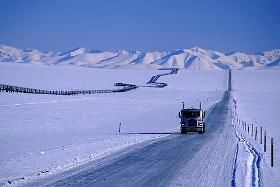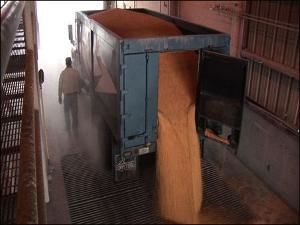what weight requires you to have a cdl
Section 1: Rules And Regulations
i.one Commercial Motor Vehicle Safety Act - Nationwide CDL Program

The Commercial Motor Vehicle Safety Act of 1986 (CMVSA) was passed past Congress to address the bug acquired by irresponsible and unqualified bus and truck drivers who are dissentious the epitome of a safety-conscious profession. Unqualified drivers, often licensed following inadequate testing in many other states, have been plant to be the cause of tragic accidents and other threats to highway safe. Many times, these drivers sought to escape responsibility for their actions by carrying driverʼs licenses issued by many states and spreading their traffic convictions amidst these licenses - thus avoiding suspensions or revocations.
The CMVSA was designed to cease these abuses by prohibiting drivers from holding more than i license. A nationwide information system prevents the issuance of multiple licenses, allows states to exchange data on traffic violations and makes information technology easier to remove problem drivers from the route. Those drivers who violate the law are field of study to tougher penalties.
In addition, the police requires states to adopt uniform testing standards for commercial drivers prior to licensing. These testing standards are similar to those in outcome for years.
Finally, sanctions for serious traffic violators volition help ensure that commercial drivers remain accountable for their actions.
one.2 Drivers Who Must Obtain a CDL
A CDL must be obtained by the driver of whatever of the following vehicles:
- Whatsoever combination of vehicles with a gross combined weight rating (GCWR) of 26,001 or more pounds, providing the gross vehicle weight rating (GVWR) of the vehicle existence towed is in excess of 10,000 pounds.
- Any single vehicle with a GVWR of 26,001 or more than pounds, or any such vehicle towing some other not in excess of 10,000 pounds.
- Any vehicle, regardless of size, designed to send 16 or more than persons, including the commuter.
- Whatever vehicle required by federal regulations to be placarded while transporting hazardous materials.
GVWR (Gross Vehicle Weight Rating):
Value specified past the manufacturer equally the maximum loaded weight of a single vehicle or combination of vehicles, or the registered gross weight.
GCWR (Gross Combined Weight Rating):
Value specified by the manufacturer as the GVWR of the power unit plus the GVWR of the towed unit or units, or the combined registered weight of the power unit plus the towed unit(southward).
1.three Drivers Exempt from Obtaining a CDL

Under state and federal law, certain drivers are not bailiwick to the requirements of the CDL program. The Federal Motor Carrier Safety Administration has determined that these exemptions will not diminish the prophylactic operation of commercial vehicles on the highways.
The following vehicle operators are non required to obtain a CDL:
- Farm Equipment Operators - This exemption covers legitimate farm-to-market operations past farmers, non commercial grain haulers. CDLs are not required to operate vehicles:
- Controlled and operated by a farmer, a member of the farmerʼs family or an employee;
- Used to transport farm products, equipment or supplies to or from a subcontract (including nurseries and aquacultures);
- Used within 150 air miles of the farm; and
- Not used in the operations of a mutual or contract carrier; and
- Used in nursery or agricultural operations.
NOTE: For the drivers of truck-tractor semitrailers, the farmer, his or her spouse and their children, parents on both sides, brothers and sisters on both sides and their spouses operating a truck-tractor semitrailer and coming together the to a higher place criteria also are exempted from the CDL Programme. These drivers must be at to the lowest degree historic period 21, and the vehicle must have Farm plates. These drivers are still required to take the advisable CDL written, skills and road tests to exist licensed.
- Firefighting Equipment Operators - Considering most firefighting organizations accept all-encompassing initial training and re- preparation requirements for their equipment operators, Illinois waives CDL requirements for operators of firefighting equipment owned or operated by or for a government bureau, when responding to or returning from an emergency.
- Armed forces Vehicle Operators - Operators of armed services vehicles for military purposes are exempt from obtaining a CDL.
- Recreational Vehicle Operators - Recreational vehicle operators, when using the vehicle primarily for personal use, practice non need a CDL.
Brand sure you lot memorize who is required to have a CDL, including memorizing the weight limits.
You volition demand to memorize what GVWR (Gross Vehicle Weight Rating) and GCWR (Gross Combined Weight Rating) correspond and how they differ. This will very probable show up on the written examination.
It's important to memorize who is exempt from obtaining a CDL as you will probably be asked 1 or 2 questions about this.
A CDL is required to drive any of the following vehicles: A commercial motor vehicle is whatever vehicle used in commerce to send passengers or belongings with either: GVWR is the maximum operating weight of a vehicle as specified by the manufacturer, minus any trailers. A CMV is a vehicle that is used as function of a business organization, is involved in interstate commerce, and may fit any of these descriptions: The GCWR refers to the total weight of a vehicle, including all trailers. Operating While IntoxicatedCDL:
Commercial Commuter'south License (CDL)
Commercial Motor Vehicle:
GVWR:
Gross Vehicle Weight Rating
CMV:
Commercial Motor Vehicle
GCWR:
Gross Combined Weight Rating
Dm:
Dispatcher, Fleet Director, Commuter Managing director
The primary person a commuter communicates with at his/her visitor. A dispatcher can play many roles, depending on the visitor'south construction. Dispatchers may assign freight, file requests for home time, relay letters betwixt the commuter and direction, inform client service of any delays, change date times, and report data to the load planners. HOS:
Hours Of Service
HOS refers to the logbook hours of service regulations. OWI:
Source: https://www.truckingtruth.com/cdl-training-program/page1/who-is-required-to-get-a-cdl
0 Response to "what weight requires you to have a cdl"
Post a Comment